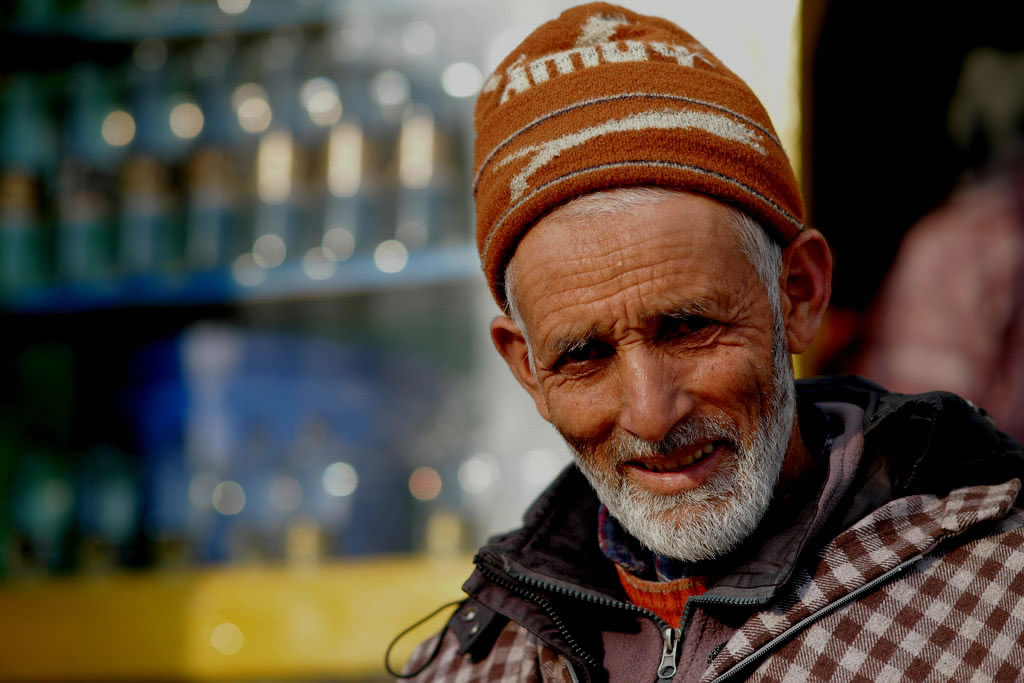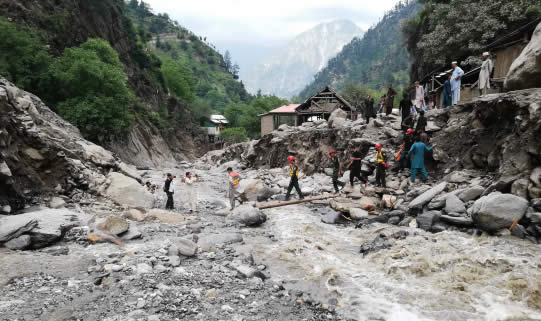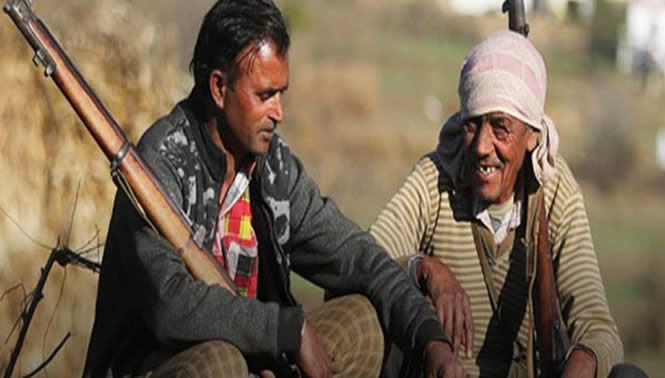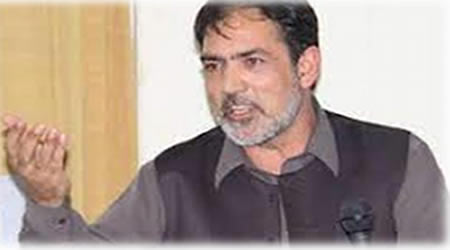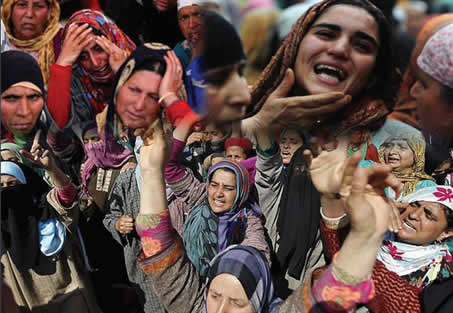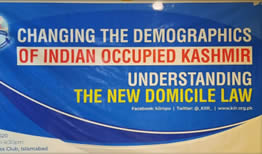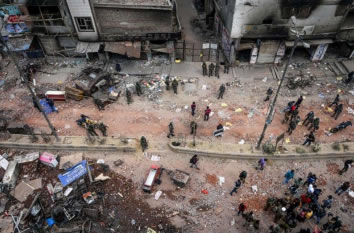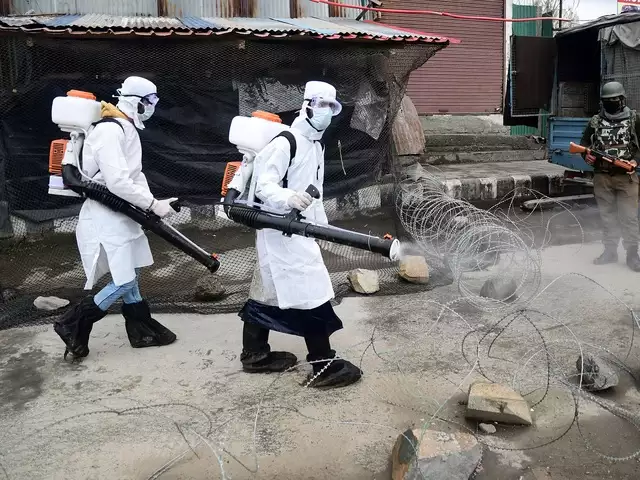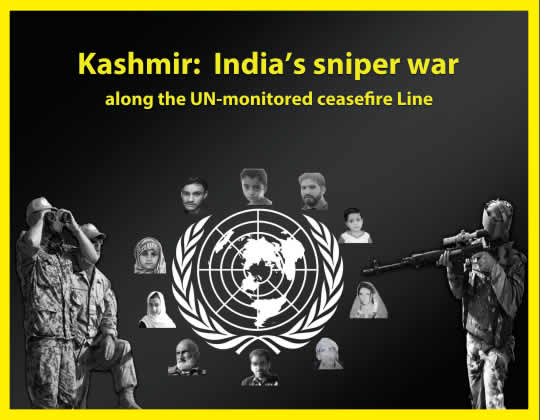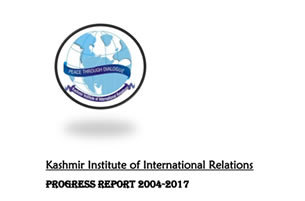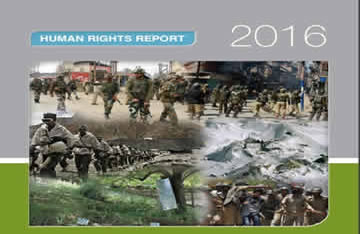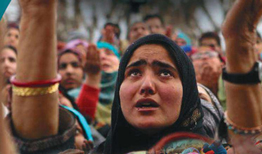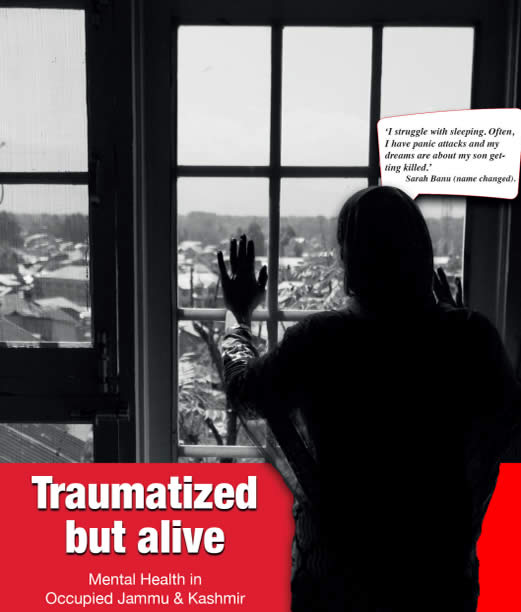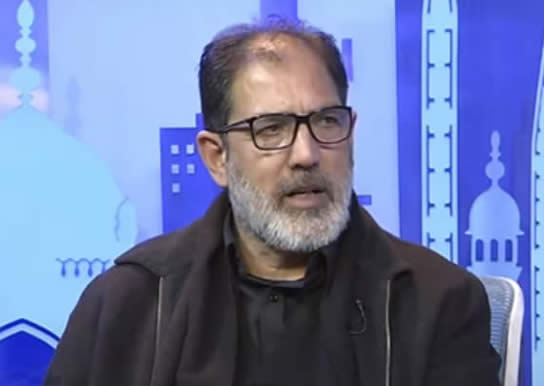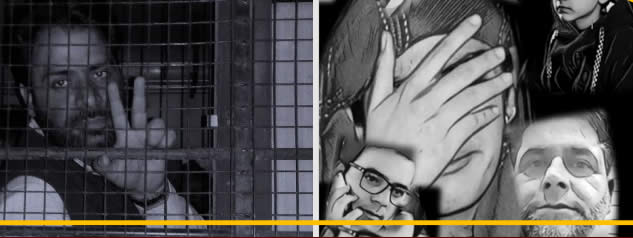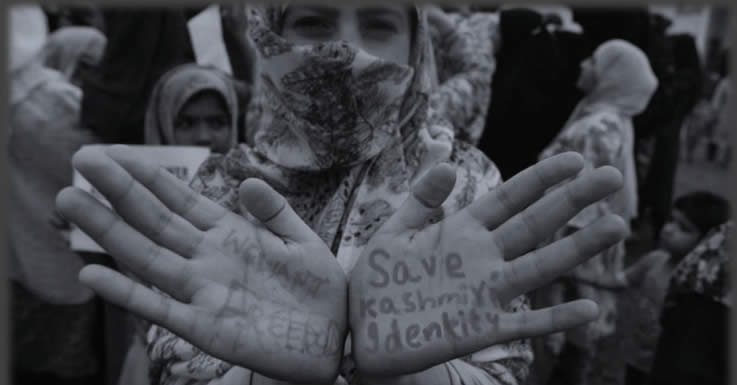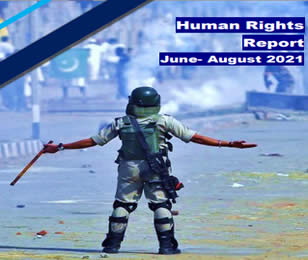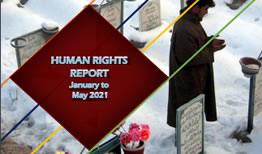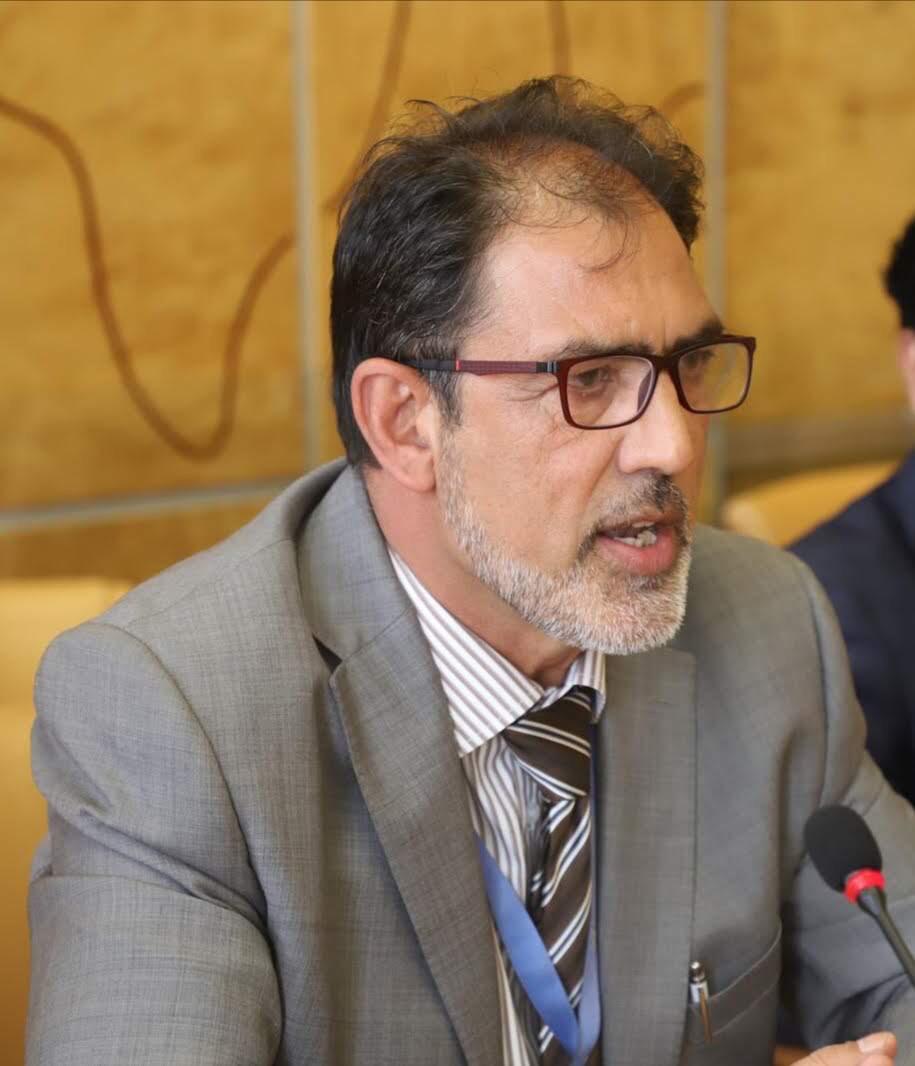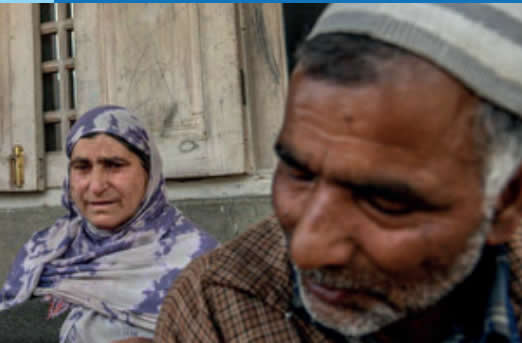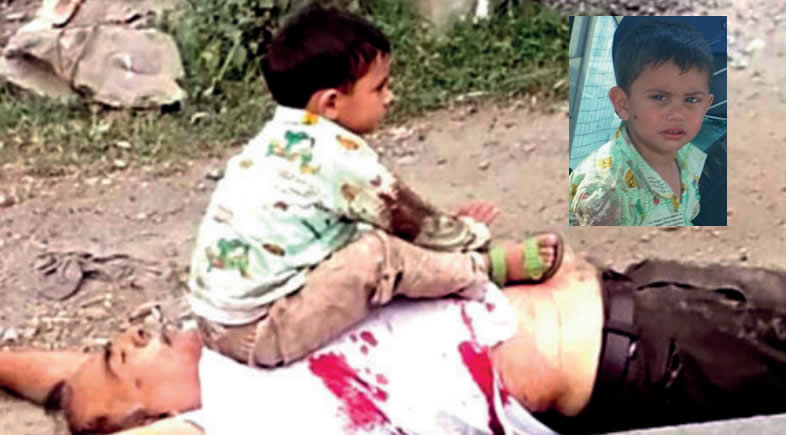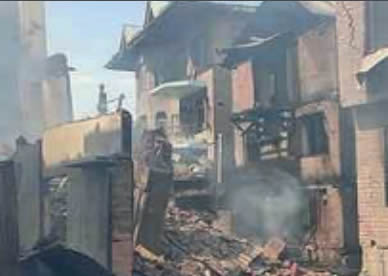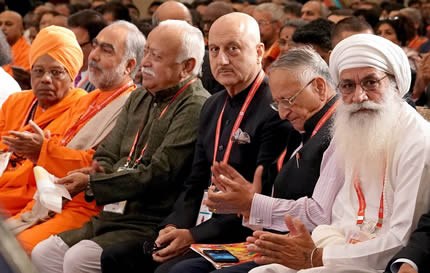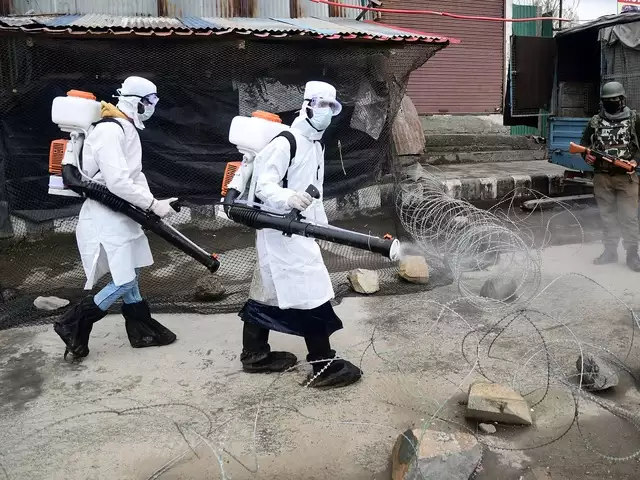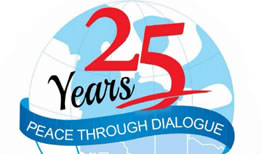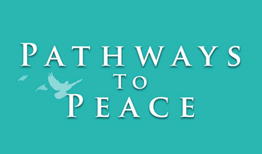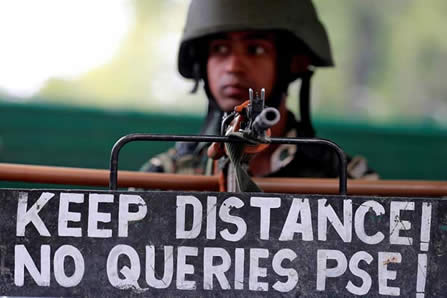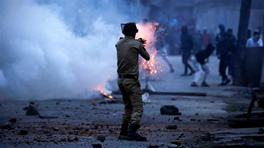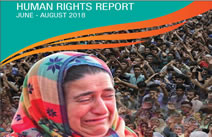5 YEARS AFTER REVOCATION OF ARTICLE 370/35-A
5 YEARS AFTER REVOCATION OFARTICLE 370/35-A
Background
Kashmir-a UN recognized disputed territory-has been in a state of a perpetual turmoil for the past several decades and its people have faced numerous challenges and human rights violations due to the continued conflict and India’s belligerent occupation. India’s imperialistic presence and a massive troops’ concentration in the region is perceived by local population as a grave threat to their existence. Continuing illegal and belligerent military occupation of Jammu & Kashmir by India and presence of over 900,000 foreign forces have led to wide ranging human rights abuses and restrictions on civilian life.
The abrogation of article 370/35-A has further exacerbated the already tense situation in the region leading to a vicious cycle of disengagement and suppression that continues unabated. Mainly, India’s for UN resolutions, which call for a plebiscite to determine the region›s future, has been a significant factor in the ongoing unrest and tensions in the region. New Delhi’s failure to implement the UN resolutions and instead seeking to unilaterally integrate Kashmir into the Indian union, has led to protracted conflict, human rights abuses, discontent and regional instability. India’s failure New Delhi’s failure to implement the UN resolutions and instead seeking to unilaterally integrate Kashmir into the Indian union, has led to protracted conflict, human rights abuses, discontent and regional instability
Kashmir: A tale of betrayals & broken promises
Kashmir is a tragic saga of India’s betrayals and broken promises. What goes on in Kashmir today is the outcome of these broken promises and the policies of deceit and deception New Delhi has been practicing since the day it invaded the region in 1947 and occupied 2/3rd of the territory of the erstwhile state of Jammu and Kashmir.
Right from 1947 till this date, this long trail of betrayals & broken promises continue to haunt Kashmiris. Pertinently, it was Indian Prime Minister Jawaharlal Nehru, who lured Hari Singh the ex-monarch of Jammu and Kashmir State, into agreeing to become a semi autonomous state under the Indian National Congress. A final agreement, which culminated in the incorporation of article 370 in the Indian constitution in 1949, granted J&K a constitution, a separate flag, and the ability for local legislators to create/amend laws on most matters except for defense and foreign policy.
An act of betrayal
Nehru also promised to hold plebiscite in Kashmir under the UN auspices. Sadly neither he himself nor his successors were serious about that promise-a macabre betrayal that has led to generation of Kashmiris to suffer and eventually raise a banner of revolt against Indian Change in state’s nomenclature Under article 370, the J&K state enjoyed a special status. The J&K state had a Sadr-e-Riyasat for Governor and Prime Minister in place of Chief Minister but later on in 1965 the nomenclature was changed to the Governor and the Chief Minister. The change in the State’s nomenclature was, by and large, perceived in Kashmir as an atrocious attack on the sovereignty and special status of Jammu and Kashmir.
Erasure of autonomy: A Constitutional fraud
Erasure of Kashmir’s autonomous status and the downgrading its sovereignty has been a continuous process. New Delhi had begun to manipulate J&K’s politics and continuously attempted to erode its special status and hollow out Article 370, particularly after Sheikh Abdullah’s deposition and arrest in 19531. However, on August 5, 2019, the Hindu nationalist government of India led by Prime Minister Narendra Modi, which saw the J&K’s semi-autonomous status as an affront to its vision of a Hindu Rashtra, committed the biggest constitutional fraud of the century, which left Kashmiris bereft of last vestiges of its autonomy2 after 70 years.
Some legal experts in India believe that constitutional change of this kind required a two-thirds majority in both Houses of the Union Parliament. While others suggested that it required the formal approval of the legislative body – the Jammu and Kashmir Constituent Assembly – which no longer existed.
Constitutional fraud
The move was widely condemned as a colonial act and even renowned constitutional expert1, AG Noorani, described it as «an illegal decision, akin to committing fraud”.
Executive Summary
Five years on, nothing has changed in Kashmir It has been five years since the Indian government revoked Jammu and Kashmir›s special status, yet the region continues to exhibit signs of distress and despair, indicating growing unrest, unceasing political and economic turmoil and a systematic marginalization and suppression of the native population by the Indian government, which has been peddling a false narrative, with much conviction, to present an all-is-well-picture of the region to the outer world. While political violence and instability continues to take a heavy toll on civilian population, nothing seems to have changed on the ground.
The GoI has miserably failed to take substantial measures till date to improve situation or address political and economic grievances of the local populace. Prevailing political disengagement is pushing Kashmiris especially the younger generation to the wall. Despite the lapse of five years, the restive region is still being remotely controlled. The GoI has not been able initiate a political process or hold assembly elections in the state. The state, which has downgraded into a Union territory in 2019, has had no elected government, and has been under the direct rule of New Delhi. Governor, a puppet-head of the state, is a mere pawn on the political chessboard it is in fact the military that call shots on the ground.
Democracy, democratic traditions and values, which India keeps bragging, off and on, have been trampled down under the jackboots. Indigenous population has no say, whatsoever, in government affairs/policies. The J&K presents a true picture of a “police state” where arbitrary detentions, high levels of incarceration and constant surveillance have generated a climate of pervasive fear3 amongst the Kashmiri masses.
Kashmir: A portrait of neglect
Years after the revocation of the article 370/35-A, the Indian occupied territory of Jammu Kashmir presents a dismal account of the deteriorating state of political and human rights, which belied the Indian government’s claims of peace and normalcy in the region The Indian government with its dimwitted policies have turned the held territory into a simmering cauldron of discontent, uncertainty and political vacuum. Political and religious gatherings have been completely prohibited, while essential human rights such as freedom of expression and opinion, as well as the right to protest and peaceful assembly remain severely restricted. Kashmiris have been reduced to second class citizens in their own homeland as a consequence of the GoI’s communal policies.
Deepening turmoil has had significant impact on the region’s economy. Businesses have suffered immense losses. Rising poverty, hunger, joblessness and unemployment in the region have left the Modi government’s mantra of so-called development completely exposed. Every action Indian government took after the repeal of article 370 have plunged the helpless Kashmiris into a deep sense of hopelessness and despair. Especially the ruling elite’s repugnant disregard for the rights of the Kashmiri people, with no signs of any amelioration, has pushed hapless Kashmiris to a chasm.
In a media interview, the ex CM of Kashmir Farooq Abdullah described Kashmiris as “slaves” who he said are being treated as second class citizens1 of the country. Rubbishing the BJP’s claims that the people of J&K have accepted the abrogation of Article 370, Dr. Abdullah said “If the Army troops are lifted from the streets of Kashmir, people would come out in huge numbers to protest against the move”.
Despite lofty claims of normalcy and development nothing has changed on the ground in Kashmir. While the people of the disputed territory feel completely robbed of their identity, rights and other privileges a deep sense of anger and alienation against Indian continues to grow beneath the layers of deadly silence, which is being portrayed by India as normalcy.
5th August marks an onset of colonial project
The consequences of the revocation of article 370/35-A of the Indian constitution can neither be overstated nor underestimated owing to its wide-ranging political and socio-economic effects on the Kashmiri society. To begin with, it has facilitated an unprecedented land-grab, which the indigenous Kashmiris believe was aimed at diluting4 the Muslim-majority character of the disputed territory, now directly under New Delhi’s control.
Demographic Change
Some 430,000 new domicile certificates have been issued —since 2019 Siddiq Wahid, a historian and political analyst from Kashmir, told AFP. “It was done with the intent to open the gates to demographic flooding.” Following the attempted annexation of the territory, the Indian government enacted a series of new laws besides modifying age-old land laws of Kashmir to allow any of its nationals to buy land in the disputed Indian-administered Kashmir. Resultantly, authority over public lands was passed from the state government to New Delhi, which has evicted locals and sold plots to new arrivals. “The erosion of political agency has disempowered and alienated Kashmiris as authoritarian dictates supersede democratic processes. The introduction of a new residency policy and changes to land laws further disenfranchise indigenous communities, exacerbating economic inequalities and fuelling resentment”.
Pertinently, before the annulment of these constitutional provisions (Article 370 and 35-A), outsiders/non state subjects were not entitled to acquire property, citizenship rights or right to seek government jobs in Kashmir. However, the contentious move by the BJP government to repeal article 370/35-A on August 05 2019 signaled the beginning of a settler-colonial project that seeks to take hold of Kashmir and its resources, by hook or by crook. It had left the region completely exposed to Indian settlers and industrialists and Kashmiris justifiably fear being turned into a minority in their homeland and eventually driven out. After the amendment in article 35-A different categories of people from anywhere in India can apply for domicile certificates.
These include those living in Kashmir for 15 years, who include around 28,000 refugees who fled Pakistan and as many as 1.75 million migrant laborers — most of whom are Hindus. After Indian government›s unilateral decision Sandeep Chakravorty6, India’s consul-general in New York City, in November 2019, told a gathering of expatriates that settlements have “happened in the Middle East. If the Israeli people can do it, we can also do it.” Chakravorty’s statement serves as an eye-opener for the world that has chosen to stay silent over India’s settler-colonialism policies-driven by a desire to transform the Kashmiri people into a disempowered minority in their own land.
“Settlements have happened in the Middle East. If the Israeli people can do it, we can also do it.” says Sandeep Chakravorty, India’s consul-general in New York City, November 2019 The GoI’s policy of so-called industrialization of Kashmir has virtually put the whole region on sale. The policy, decked out as an effort to bring jobs and prosperity to people of the occupied territory, has virtually opened floodgates for Indian-settlers to expropriate land from locals and then. The policy to “transform” Jammu and Kashmir into an “industrialized territory” was introduced in 2021.
Under this policy New Delhi received more than $10 billion of “investment proposals” to build a vast network of luxury hotels, IT campuses, medical centers, movie theaters, cement factories, malls, a film city, in Kashmir. Indian capitalists are also buying up land in Kashmir on throw-away rates and received hefty land acquisition rights and compensation from the concerned authorities. As of last year, the government had allotted land to 1,854 industrial units. In February 2023 Sajjan Jindal, who chairs a conglomerate called JSW Group, posted on X that he had “laid the foundation stone” for a nine-acre steel factory in the southern town of Pulwama.
Jindal vocally supported the revocation of Article 370. Similarly, the UAE-based Emaar Group had desired to set up a shopping complex in Srinagar. So who is all this infrastructure meant for? Surely not the Kashmiris, who believe that this so-called investment and infrastructure is aimed at facilitating ambitious Indian industrialists and creating jobs of Indian workers who will disrupt the region’s Muslim demography. “The claims of normalcy in Jammu and Kashmir are far from reality. In fact, there is no stability anywhere in (J&K), rather devastation has added manifold” says Omar Abdullah
Key effects of abrogation of Article 370.
The abrogation of article 370/35-A have had significant impacts on Kashmir›s politics, socio-political landscape, and administrative structure. Here are some key effects:
1. Socio-Political Impacts:
1.1. Loss of autonomy: The revocation of Article 370 has led to the loss of Kashmir›s political autonomy, as the state is no longer allowed to have its own constitution, flag, and independence over internal administration.
1.2. Forced integration with India: The move, widely decried by Kashmiris as act of colonialism, raised concerns about its potential impact on the demographic composition of the region
1.3. Protests and violence: The revocation has triggered widespread protests and violence in Kashmir, with many Kashmiris feeling that their rights and identity are under threat.
1.4. Detention of Politicians: Hundreds of Kashmiri politicians, including top rank Hurriyat leaders, former chief ministers were detained by the Indian authorities, leading to a political vacuum in the state.
1.5. Restrictions on movement: Restricting movement of people, including politicians, journalists, and civilians. 1.6. Arbitrary arrests and Detentions: Arresting and detaining thousands of people, including political leaders, activists, and civilians.
1.7. Economic Consequences: The revocation has had significant economic consequences, including the loss of jobs, businesses, and livelihoods, particularly in the tourism sector. 1.8. Exploitative resource extraction: Since 2019, Kashmir has witnessed a wholesale exploitation of its resources. Outsiders (Non-Kashmiri) were given a free hand to loot and plunder the state resources while local investors were left high and dry. For example, mining, stone quarry and material contracts were awarded to non-locals while natives suffered for want of materials in Kashmir.
According to reports, seventy percent (70%) of the mineral extraction contracts in Kashmir were granted to non-Kashmiris during these years. Handing over Kashmir’s mineral contracts to non- locals has led to a surge in the cost of materials, forcing local residents to suspend construction work. The mining contracts to outsiders have also robbed locals of job opportunities.
1.9. Growing unemployment & joblessness: Growing unemployment is one of the burning issues that has been ailing Kashmiri society today. Contrary to the Indian government’s claims of so-called development, the unemployment rate in Kashmir has swelled to 23.1% in 2023.
1.10. Enhanced Military Presence: Additional troops were deployed in the region to strengthen the security grid in the state.
1.11. Suspension of Civil Liberties: Civil liberties, including the right to freedom of speech and assembly, right to protest and religious rights were severely restricted.
1.12. Enforcement of draconian laws: Following the abrogation of article 370, a series of news laws were enacted/enforced in Kashmir, granting sweeping powers to security forces.
1.13. Changes in Domicile & Land Laws: These laws were specially amended to pave the way for non- residents/ non-state-subjects to purchase land and settle in the state.
These measures have had significant impacts on the lives of Kashmiris, including restrictions on their freedoms, economic hardships, and psychological trauma. These actions have also lent an impetus to the BJP’s dream project of erasing the region’s distinct identity as a Muslim majority state and rewriting its history.
2. Change in administrative structure
2.1. Bifurcation of the State: The revocation of Article 370 has led to the bifurcation of the state into two union territories: Jammu and Kashmir, and Ladakh.
2.2. Governance: The move has led to a change in the governance structure of the state, with the Indian government now having more control over the administration of Kashmir.
2.3. Constitutional Changes: The revocation has also led to constitutional changes, with the Indian constitution now applicable to Kashmir in its entirety.
3. Reshuffle of bureaucracy:
3.1. Centralization of power: Reshuffle of bureaucracy led to centralization of power, consolidating control over the administration of Kashmir by appointing officers loyal to the central government.
3.2. Weakening local bureaucracy: Undermining the influence of local bureaucracy by removing them from key positions.
3.3. Implementing Hindutva Agenda: Promoting the Hindutva ideology by appointing officers who share similar beliefs.
3.4. Cracking Down on Dissent: Suppressing dissent and opposition by removing officers who may be sympathetic to the Kashmiri people›s demands for autonomy or freedom.
3.5. Punishing “Anti-National” Elements: Identifying and punishing officers or employees who may be perceived as “anti-national” or sympathetic to separatist movements.
3.6. Efficient Implementation of Hindutva Policies: Ensuring efficient implementation of Hindutva policies and decisions made by the central government.
4. Dismissal of employees & attachment of properties Dismissal of government employees and attachment of civilian properties is form of collective punishment Kashmiris are being subjected to by the Indian government since a long time, however, this insidious practice of collective punishments has gained momentum after 5th August 2019. Attachment of civilians› properties, harassment and suspension of government employees on mere suspicion is yet another terrifying aspect of settler colonialism that seeks to disempower indigenous population and dispossess them from their rightful properties they have inherited from their ancestors.
More than 164 Kashmiri employees have been unlawfully dismissed from their services on mere suspicion by the Indian occupation authorities ever since the abrogation of article 370. Whereas over 600 properties have been seized under controversial UAPA
4.1. Termination of employees: According to reports the puppet authorities in IIO J&K has terminated over 164 employees from their services ever since the abrogation of article 370. Observers believe that Kashmiri Muslims are being selectively targeted merely on suspicion.
4.2. Attachment of properties: Similarly, moveable and immovable properties of hundreds of Kashmiris were attached under the Unlawful Activities (Prevention) Act (UAPA)-the controversial law that has been criticized for being used to targetand silence political opponents, activists, and journalists.
It is worth mentioning that the Modi regime had already over 600 properties in Kashmir since 2019.However, according to various reports and news articles, properties of several individuals, including pro-freedom leaders and politicians, civil society activists and human rights defenders, journalists and media personnel, businessmen and entrepreneurs, religious leaders and scholars have been attached or seized under the UAPA in Kashmir. These individuals are often accused of being involved in “anti-national” activities, terrorism, or other crimes, but the accusations are often controversial and disputed. Some specific examples include: I. The property of late Syed Ali Shah Geelani, a prominent Kashmiri leader, was attached in 2020. II. The property of Yasin Malik, a senior Kashmiri leader and chairman of the Jammu and Kashmir Liberation Front (JKLF), was attached in 2020. III. The property of Shabir Ahmed Shah, a prominent Hurriyat leader and president of the Jammu and Kashmir Democratic Freedom Party (DFP), was attached in 2020. IV. The property of several Kashmiri journalists, media owners were attached in 2020. V.
Kashmir Times regional office in Srinagar was sealed by the local administration. Please note that these are just a few examples, and many more individuals may have been targeted under the UAPA in Kashmir. Overall, the actions Indian government took in Kashmir in the aftermath of the abrogation of article 370/35-A have had far-reaching consequences for Kashmir›s politics, socio-political landscape, and administrative structure, and have been widely criticized by rights bodies.
5. Racial gerrymandering
After the abrogation of 370, the Indian government took some drastic measures that besides changing the electoral landscape led to further disempowerment and disenfranchisement of its people. The redrawing of assembly segments and granting six additional seats to the Jammu region against only one seat for Kashmir was one amongst the plethora of measures that exposed the partisan and racial gerrymandering by New Delhi. The controversial move reduced the role of the region’s majority community by making their votes irrelevant in the electoral process7 A former Chief Minister in a media interview described the delimitation process in the Indian held territory (IHK) of J&K as a ploy to aid the BJP’s election prospects and effect a demographicchange8
. “By redrawing the boundaries of the Assembly constituencies, the BJP seeks to increase its electoral footprint in India’s only Muslim majority State, and also make way for demographic changes, so as to reduce the Muslim majority into a minority”, she said. Many Kashmiris are convinced that the Indian government is seeking to reorganize the landscape of Jammu and Kashmir by changing its demography. Some call this ‘settler colonialism’ that may disempower Kashmiris in the long-term.
5.1 Revised electoral rolls
The electoral roll revision followed the creation of new seats in the local legislature by a special re-delineation commission in 2022. The roll revision was mainly aimed to include in the electoral list non state subjects including mainly members of the security and armedforces deployed in the region, and members of India’s Hindu Kashmiri Pandit diaspora. Under this scheme these groups were entitled to register as voters in their respective constituencies even if they were not physically present in Jammu and Kashmir. Several Kashmiri political parties criticized the electoral changes, calling the new electoral designs ‘the last nail in the coffin of electoral democracy in Jammu and Kashmir’. Addition of 2.5 million new voters, on the other hand, triggered outrage and raised concerns that the ruling Bharatiya Janata Party (BJP) is seeking to shift the nature of politics in the region in its favour.
The Delimitation Commission’s recommendations were apparently unjustified and illogical as the size of population, which happens to be the cardinal parameter in such processes, has been grossly overlooked and ignored while creating new constituencies.
“Changes to electoral rules in Jammu and Kashmir, including the potential addition of 2.5 million new voters, have triggered outrage and raised concerns that the ruling party (BJP) is seeking to shift the nature of politics in the region in its favour”.
Has the delimitation process conducted fairly, the commission might have given 51 seats to Kashmir and 39 to Jammu. However, notwithstanding the fundamental principles, the commission, on the contrary, recommended six additional seats to Jammu and just one for Kashmir region, which is bigger in size in terms of population.
6. Illegal Attachments: A Hallmark of settler colonialism
The attachment of civilians› properties, harassment, and suspension of government employees is a disturbing trend that perpetuates the displacement and disempowerment of the indigenous population in Kashmir. This phenomenon is a hallmark of settler colonialism, aimed at:
6.1. Dispossessing natives of their land and properties: A tactic to erase the indigenous identity and perpetuate the dominance of the settler population.
6.2. Disempowering the local population: By targeting government employees, the aim is to undermine the local administration and decision-making processes, further marginalizing the indigenous population.
6.3. Instilling fear and uncertainty: Harassment and suspension of employees on mere suspicion create a climate of fear, making it difficult for locals to assert their rights or resist the settler colonial agenda.
6.4. Eroding cultural heritage: The attachment of properties and land threatens the cultural heritage and historical legacy of the indigenous population, paving the way for cultural erasure.
6.5. Consolidating settler control: By dispossessing natives of their properties and disempowering the local population, the settler colonial project aims to consolidate its control over the region, perpetuating a system of oppression and domination.It is important to note here that forced evictions violate a range of human rights including adequate housing, standard of health, education, social security.
Last year’s land eviction and anti-encroachment drive, has left thousands of Kashmiris homeless and disposed of their lands and properties they had inherited from their ancestors. Under the guise of these newly introduced laws, the Indian occupation authorities have forcibly evicted and dislodged the civilian populations from agricultural and non-agricultural properties that they have occupied for generations. People, of all hues, were affected by this policy, which bears the imprints of a settler colonialism. From nomads living in the mountains to those settled in cities, towns and villages have seen their properties being seized and demolished by the occupation authorities after the disputed territory “Jammu and Kashmir” was reduced to a union territory in August 20199.
Dislodging people of their properties, lands and jobs is not only utter disregard to international law, but also an antithesis to the spirit of basic democracy and fundamental human right According to a report, land measuring 178005.213 acres in the Kashmir region — and 25,159.56 acres in Jammu — has been identified by the authorities as state property people have “occupied illegally”. Thousands of people have been rendered homeless as bulldozers were let loose to demolish structures and homes across the Kashmir valley and Jammu region.
“It was an unprecedented exercise of mass dispossession. According to official data, more than 42,000 hectares were seized. The evictions were paused only when protests threatened to break out.” writes Tariq Mir in New York Times
On land eviction drive, the former J&K Chief Minister Omar Abdullah said, “Centre is trying to reverse the radical ‹land to the tiller› reform of Sheikh Abdullah. Former state chief minister Mehbooba Mufti said, “The demolition drive is turning the situation in Kashmir worse
than Palestine” This is a grave concern, and the international community must take notice of these issues and lent its support to the indigenous population of Kashmir in their struggle for self-determination and rightful ownership of their lands and properties.
7. Political disengagement
The political disengaement in Kashmir is indeed a significant concern. The Indian government›s inability to resume a political process in the region has led to a governance vacuum, resulting in:
7.1. Remote governance: Kashmir is being governed remotely by New Delhi, without adequate representation or participation from local leaders or the people.
7.2. Disconnection from the political process: The lack of a political process has disconnected the people of Kashmir from decision-making, exacerbating feelings of disenfranchisement and alienation.
7.3. Erosion of trust: The prolonged absence of a political process has eroded trust in the Indian government›s intentions, further polarizing the situation.
7.4. Growing unrest: The political disengagement has contributed to growing unrest, as people feel their voices are not being heard in any way and their concerns are not being addressed. The Indian government›s inability to resume a political process in Kashmir has created a power vacuum, fueling unrest, disillusionment, and a sense of disconnection among the people. To address the situation, it›s essential to initiate an inclusive and meaningful political process that engages all the stakeholders including local leaders, civil society, and the people of Kashmir to find out a permanent solution to the dispute.
8. Amendment in Business Rules
On July 12, this year (2024) the Indian Ministry of Home Affairs extended the administrative authority of the Lieutenant Governor (LG) of Jammu and Kashmir by amending the Transaction of Business Rules10 through an executive notification. Fresh amendments in Business Rules further minimized the role of elected representatives in administrative affairs of the state besides granting enhanced authority to governor in Kashmir over key appointments and services including transfers and postings of all-India service officers, police, and the appointment of legal counsels.
Now as long as J&K remains a union territory an elected chief minister or his cabinet will have no powers to transfer the administrative officers/secretaries. The move triggered widespread condemnation and concerns from local as well Indian opposition parties and leaders terming it as an attempt to reduce the powers of legislative assembly and the elected representatives of the state11 .Generally, changes to existing laws can have significant impacts on a region, including shifts in power dynamics, changes to governance structures, and effects on the local population. However, this is for the first time that the Lieutenant Governor has been authority to grant sanction for prosecution12 in different cases and matters connected with prisons.
President of the Indian National Congress, Mallikarjun Kharge, strongly condemned the recent amendment, accusing the Modi government of continuing its betrayal of Jammu and Kashmir by granting more powers to the Lieutenant Governor (LG) Ex CM of J&K Mehbooba Mufti criticized the amendment for reducing the once-powerful legislative assembly to a mere municipality. NC leader Tanvir Sadiq termed the government’s move to grant powers to an unelected lieutenant governor instead of an elected government is a clear attempt to undermine the future of a democratically elected government in Jammu and Kashmir.”
Attempts to deflect world attention away from Kashmir The Indian government has been widely criticized for using mainstream media to shape public opinion and perpetuate a narrative that downplays the severity of the situation in Kashmir. This includes:
I. Selective reporting: Highlighting stories that showcase normalcy and development, while ignoring or downplaying reports of human rights violations and unrest.
II. Biased coverage: Presenting a one-sided view of the conflict, portraying the Indian government›s actions as justified and legitimate, while dismissing Kashmiri perspectives and concerns.
III. Disinformation campaigns: Spreading false or misleading information to discredit Kashmiri leaders, activists, and international critics, and to shape public opinion in favor of the government›s narrative.
IV. Media censorship: Imposing restrictions on media outlets and journalists who attempt to report on the situation in Kashmir, including arrests, detentions, and intimidation tactics.
V. Propaganda campaigns: Launching targeted propaganda campaigns to influence public opinion and shape the narrative on Kashmir, often using social media and other digital platforms. By relying on media to peddle a narrative of normalcy and development, the Indian government aims to:
• Deflect international attention away from the human rights situation and political unrest in Kashmir.
• Discredit Kashmiri voices.
• Project a false image of stability and normalcy in the region, despite the ongoing unrest and humanitarian crisis. Critics argue that this approach perpetuates a false narrative, obscures the reality of the situation, and contributes to the ongoing suffering of the Kashmiri people13.
Restrictions on media
The local press in Kashmir has faced significant restrictions and intimidation since 2019, leading to a severe curtailment of their ability to report on the situation in Kashmir. These restrictions have effectively silenced the local press in Kashmir, preventing them from reporting on the situation and denying the public access to accurate and reliable information. International media outlets have also faced restrictions and intimidation, making it challenging to report on the situation in Kashmir. Silencing human rights defenders According to reports by renowned international human rights organizations the humanitarian work has come to a grinding halt after prominent human rights defenders in Kashmir have been arrested and many organizations banned under terror laws such as UAPA.
These reports have highlighted the severe constraints on humanitarian work in Kashmir, particularly after the arrest of prominent human rights defenders and the ban on several organizations under terror laws, including the Unlawful Activities Prevention Act (UAPA). These actions have led to: Indian authorities appear to be intensifying the long- standing repression of Kashmiri civil society,” said MaryLawlor, UN Special Rapporteur on the situation of humanrights defenders.
1. Silencing of human rights voices: The arrest of human rights defenders has silenced critical voices that were documenting and reporting human rights violations in Kashmir.
2. Restrictions on humanitarian work: The ban on organizations and the fear of reprisal have severely restricted the ability of humanitarian groups to operate in Kashmir, leaving vulnerable populations without access to essential services and support.
3. Ban on rights groups: The designation of certain organizations as «terrorist» under UAPA has made it difficult for rights groups to work and operate independently, which has further exacerbated the humanitarian crisis in Kashmir.
4. Intimidation and harassment: Human rights defenders and humanitarian workers have faced intimidation, harassment, and reprisals, creating a climate of fear that makes it challenging to carry out their work.
Note: These developments have severely undermined the ability of human rights defenders and humanitarian organizations to operate in Kashmir, leaving the region›s vulnerable populations without adequate Banning legitimate political voices/ organisations
The Indian actions to ban Kashmiri political parties has indeed created a climate of fear and a sense of disenfranchisement among the people of Kashmir. This move has led to:
1. Denial of political representation: By banning political parties, the Indian government has denied the people of Kashmir their right to political representation and a voice in the political process.
2. Suppression political dissent: The ban has suppressed political dissent and silenced voices that were critical of the government›s actions in Kashmir.
3. A sense of disenfranchisement: The ban has left Kashmiris feeling disenfranchised and disconnected from the political process, further exacerbating the sense of alienation and disconnection.
4. A climate of fear: The ban has created a climate of fear, where political activity is seen as a risky endeavor, and people are hesitant to engage in political discussions or express themselves publically.
5. Undermined democratic principles: The ban has undermined democratic principles and values, such as freedom of speech, assembly, and association, which are essential for a healthy democratic society.
Banning of the political parties and persecution of their leadership manifest a desire to stifle dissent in sheer disregard of democratic norms and international human rights and humanitarian law.
Note: By banning Kashmiri political parties, the Indian government has perpetuated a cycle of repression, further entrenching the political crisis in Kashmir. This ban has further isolated Kashmiris, making them more vulnerable to human rights abuses. The international community has condemned this move, recognizing the critical role civil society organizations play in promoting and protecting human rights.
Steamrolling the will of Kashmiri people
1. Relentless State Repression
The Indian government›s relentless attempts to suppress the genuine aspirations of the Kashmiri people continue unabated. Since 2019, Kashmir had witnessed a gradual and steady surge in state repression. Despite claims of normalcy by the Indian government, the Kashmir Valley has seen 263 incidents of violence since 2021, with 417 resistance fighters, 68 Indian soldiers, and 75 civilians killed. Jammu province, which has been relatively calm, recorded more causalities in 2024 resulting in death of 19 civilians, 48 fighters and 49 Indian soldiers14.
In addition to using various forms of violence, the Government of India also resorted to seizing civilian properties, taking over land, and demolishing civilian structures, along with inflicting torture, carrying out forced disappearances, and engaging in extrajudicial killings, all as means to silence the people of Kashmir and suppress their legitimate political aspirations. Individuals advocating for the right to self-determination continue to face severe harassment, torture, and even extrajudicial killings. Agencies such as the National Investigation Agency (NIA) and the State Investigation Agency (SIA), Enforce Department (ED) have been weaponized to target Kashmiris especially those championing the cause of freedom and dignity of human rights. The continued killings of security personnel, civilians, and militants in the Union Territory raised doubts about the government’s assertions of having restored peace
2. HR violations
Since 5 August 2019, the Kashmir region recorded deaths of at least 907 civilians, mostly young boys, who were killed after being daubed as foreign militants by the Indian troops during the so-called counter-insurgency operations. Whereas 2,442 civilians have been critically wounded during the operations or tortured during interrogation. 24,904 Kashmiris have been arrested from time to time under trumped up charges. Moreover, 1,122properties including residential houses, business centers, and shops have been destroyed. The violence related incidents have left 69 women widowed and 187 children orphaned.
A report15 released by a news gathering agency, revealed that the killings since 05 August 2019 have been higher than those in 2011, 2012, 2013, 2014, and 2015. It said, most of the victims were killed in fake encounters, cordon and search operations and in police custody. According to the Ministry of Home Affairs, 1,050 guerrilla fighters and 319 Indian troopers have died in combat between 2018 and 2023. However independent observers gave the figure of deaths even higher than are being cited by the government sources.
Chart# 1 shown below shows HR violations in Kashmir since 2019
Silencing human rights defenders, journalists, and political activists under the guise of anti-terror laws such as UAPA, PSA, AFSPA, TADA, POTA, NSA, and other laws have fueled the climate of fear and repression. Unlawful Activities Prevention Act (UAPA) remains the most misused law, which allows for the detention of individuals without trial for up to 180 days and has been used by the Indian authorities in Kashmir to arrest political leaders, activists, journalists, and students. Sedition Law (Section 124A of the Indian Penal Code: This colonial-era law criminalizes free speech deemed as “seditious” and has been used to silence critics of the government. Similarly, the National Security Act (NSA) allows for the detention of individuals without trial for up to 12 months and has been used to silence activists and journalists in Kashmir and elsewhere in India.
The Public Safety Act (PSA) is a Kashmir specific law, which allows for the detention of individuals without trial for up to 2 years. Likewise, the AFSPA grants Indian military and other law enforcement agencies sweeping powers to arrest, search, and shoot, and has been criticized for being the main cause and consequence of human rights violations in the restive region.
The FCRA law regulates foreign funding for NGOs and has been used to silence civil society organizations critical of the government. These anti-terror laws brazenly violate the universal safeguards guaranteed under UDHR, ICCPR & other international conventions. Sadly, the people of Kashmir continue to face significant challenges, including widespread human rights violations, violence, intimidation and harassment.
3. Use and abuse of anti-terror laws
The Indian government’s use of anti-terror laws against civil rights activists and journalists in Kashmir and other regions has caused widespread concern internationally as calls for holding India accountable have grown significantly after the deterioration of political and human rights situation in the Indian occupied Kashmir. Decried for their vague language, broad scope, and potential for abuse, the widespread application of these notorious laws has resulted in a decline in democratic freedoms and human rights not only in Kashmir but other parts of India. In Kashmir, these laws have been arbitrarily used to detain political leaders, activists, and journalists without fair trial, stifle protests and demonstrations, censor free been used to silence activists and journalists in Kashmir and elsewhere in India. The Public Safety Act (PSA) is a Kashmir specific law, which allows for the detention of individuals without trial for up to 2 years. Likewise, the AFSPA grants Indian military and other law enforcement agencies sweeping powers to arrest, search, and shoot, and has been criticized for being the main cause and consequence of human rights violations in the restive region. The FCRA law regulates foreign funding for NGOs and has been used to silence civil society organizations critical of the government.
These anti-terror laws brazenly violate the universal safeguards guaranteed under UDHR, ICCPR & other international conventions. Sadly, the people of Kashmir continue to face significant challenges, including widespread human rights violations, violence, intimidation and harassment.
3. Use and abuse of anti-terror laws
The Indian government’s use of anti-terror laws against civil rights activists and journalists in Kashmir and other regions has caused widespread concern internationally as calls for holding India accountable have grown significantly after the deterioration of political and human rights situation in the Indian occupied Kashmir. Decried for their vague language, broad scope, and potential for abuse, the widespread application of these notorious laws has resulted in a decline in democratic freedoms and human rights not only in Kashmir but other parts of India. In Kashmir, these laws have been arbitrarily used to detain political leaders, activists, and journalists without fair trial, stifle protests and demonstrations, censor free speech and expression and silence opposing voices.
In Kashmir, these laws have been arbitrarily used to detain political leaders, activists, and journalists without fair trial, stifle protests and demonstrations, censor free speech, and silence opposing voices.
“Civil rights activists, politicians and youth are imprisoned and their voices stifled by draconian measures taken under the guise of national security. Suppression of dissent has become endemic, and citizens are subjected to surveillance and censorship that undermine fundamental freedoms.
Global outcry over misuse of anti-terror laws
Unfortunately, the Indian governments have escaped global scrutiny due to the continued influence of realpolitik in global politics. However, there are still many organizations, individuals, and countries advocating for human rights in India and Kashmir. Many groups, such as Amnesty International, Human Rights Watch, Jammu and Kashmir Coalition of Civil Society, and International Federation for Human Rights, have submitted reports to human rights bodies or the UN Commissioner for Human Rights regarding the human rights conditions in Kashmir.
These groups along with Kashmiri activists have submitted reports, written and oral statements, during the recently concluded 56th session of UNHRC, they met the officials of the Office of the High Commissioner for Human Rights and sought investigations and accountability for abuses that have taken place in Indian Kashmir. Earlier, the UN Special Rapporteurs have also criticized India for its abuse of draconian laws, particularly in the context of Kashmir. The former Special Rapporteur16 on Torture, Nils Melzer, David Kaye17, the former Special Rapporteur on Freedom of Expression, Mary Lawlor, the Special Rapporteur on Human Rights Defenders, and Agnes Callamard, the former Special Rapporteur on Extrajudicial Executions, the current special rapporteur Morris Tidbal criticized the harassment and intimidation of human rights defenders in Kashmir18. Ahead of Indian delegation’s appearance before the UN’s Human Rights Committee in July this year, in as many as 24 joint communications special rapporteurs had raised their concern over reported extrajudicial killings, arbitrary detentions, destruction of property, use of excessive force and misuse of draconian laws by India and havespeech and expression and silence opposing voices.
These groups along with Kashmiri activists have submitted reports, written and oral statements, during the recently concluded 56th session of UNHRC, they met the officials of the Office of the High Commissioner for Human Rights and sought investigations and accountability for abuses that have taken place in Indian Kashmir. Earlier, the UN Special Rapporteurs have also criticized India for its abuse of draconian laws, particularly in the context of Kashmir. The former Special Rapporteur16 on Torture, Nils Melzer, David Kaye17, the former Special Rapporteur on Freedom of Expression, Mary Lawlor, the Special Rapporteur on Human Rights Defenders, and Agnes Callamard, the former Special Rapporteur on Extrajudicial Executions, the current special rapporteur Morris Tidbal criticized the harassment and intimidation of human rights defenders in Kashmir18.
Ahead of Indian delegation’s appearance before the UN’s Human Rights Committee in July this year, in as many as 24 joint communications special rapporteurs had raised their concern over reported extrajudicial killings, arbitrary detentions, destruction of property, use of excessive force and misuse of draconian laws by India and have urged for thorough investigations into these incidents. Before this crucial meeting, CIVICUS19-a global alliance of civil society organisations and activists dedicated to strengthening citizen action and civil society, had submitted a detailed report to the Committee highlighting the plight of HRDs and journalists in Kashmir and declining state of civic space and human rights in the region.
India’s human rights record under UN spotlight
During the fourth periodic review by the Human Rights Committee the Indian delegation was left red faced as the UN experts persistently raised questions about the lack of implementation of India›s comprehensive constitutional and legal framework for protecting human rights and reported violence against religious minorities and misuse of terror laws. The experts specifically mentioned the use of Jammu and Kashmir Public Safety Act and J&K Public Security Act, grant of extensive powers to executive bodies to investigate and seize property based on suspicions of “terrorist” activities, undue censorship of online content, frequent suspension of mobile internet services in Jammu and Kashmir, and prosecution of persons for criticism of the Government online and prosecution of members of the armed forces.
“How were these laws compatible with the International Covenant on Civil and Political Rights? How was the State party ensuring accountability for the armed forces? What amendments would be made to counter- terrorism laws to ensure compliance with the Covenant”, the UN experts asked the Indian delegation. The Indian delegation›s reliance on the constitution to justify their actions in Kashmir, while failing to provide satisfactory answers to questions about the use of draconian laws, raises concerns about accountability and transparency. These laws have been accused of facilitating human rights violations, such as extrajudicial killings, enforced disappearances, and torture. The UN committee, in a report released in first week of August 2024, noted that certain provisions of India’s
Armed Forces (Special Powers) Act (AFSPA) and counter- terrorism laws do not comply with the International Covenant on Civil and Political Rights (ICCPR). The committee expressed alarm over the prolonged application of these laws in “disturbed areas” such as districts in Manipur, the occupied Jammu and Kashmir and Assam. Since the enforcement of the Public Safety Act, there had not been a single prosecution of members of the armed forces, although there had been over 1,500 complaints of human rights abuses by armed forces personnel. How was the State party ensuring accountability for the armed forces? What amendments would be made to counter-terrorism laws to ensure compliance with the Covenant?
It noted with concern that this extended enforcement has led to “widespread and severe human rights violations, including excessive use of force resulting in unlawful killings, prolonged arbitrary detention, sexual violence, forced displacement, and torture”
Key findings
Indian government›s sledgehammer policies have had far-reaching and devastating impacts on Kashmiri society, affecting various aspects of their lives, including:
1. Socioeconomic:
The economy has been severely affected, with:
• Loss of livelihoods
• Closure of businesses
• Disruption of trade and commerce
• Decline in tourism
• Economic downturn
• Unemployment and poverty
• Destruction of infrastructure
2. Political:
• Political disengagement
• Disenfranchisement
• Suppression of political dissent
• Detention of political leaders
• Restrictions on assembly and speech
3. Religious:
• Restrictions on religious freedom
• Desecration of religious sites
• Interference in religious affairs
4. Cultural:
• Erasure of cultural heritage
• Suppression of cultural expression
• Attempts to impose a dominant culture
• Destruction of cultural artifacts and historical
sites
5. Psychological:
• Trauma and mental health issues
• Fear and anxiety
• Loss of identity and sense of belonging Along with economy, education and healthcare has suffered enormously during the years of turmoil and uncertainty. Education: The education sector has suffered significantly, with:
• Closure of schools, colleges and universities
• Disruption of academic sessions
• Lack of access to quality education
• Decrease in student enrollment Healthcare: The healthcare sector has also been severely impacted, with:
• Shortage of medical supplies and staff
• Disruption of healthcare services
• Lack of access to quality healthcare
• Increase in mental health issues These sectors are crucial for the well-being and development of a society, however, well-being people of Kashmir has never been a priority of the Indian government that sees Kashmiris through communal lens.
Conclusion
India’s imperialistic presence in the held territory (IoJ&K) have had a devastating impact on various sectors of life with Kashmiris facing immense sufferings, uncertainty, and a loss of identity. World community has indeed expressed its concern over the issue, however, it›s essential to continue highlighting these issues to ensure that the Indian government respects Kashmiris› rights and dignity. While concerted efforts are required to find an early and amicable settlement of the lingering dispute, it is equally important that the world must realize dangers in Kashmir that has, unfortunately, witnessed new heights of assimilation and the erasure of its socio-political, religious and cultural identity during the past five years.
The GoaIs attempts to portray a false picture of Kashmir run parallel to the region’s shocking ground realities that are so glaringly opposite and at odds with what the Indian government has actually been saying and doing in the region. There is indeed a growing realization at international level that the abysmal situation in the restive region can no longer be left unaddressed, however, the responsibility for holding India›s human rights abusing regime accountable, lies with the UN and other influential world governments. Countries with substantial influence such as the US, UK, EU, Russia, and China can use their efforts to pressure India into repealing harsh laws and holding everyone accountable for their involvement in human rights violations in Kashmir. It is high time that influential world governments must stop the practice of trying to please everyone and instead focus on the more challenging work of holding states accountable for breaking the law, rather than pursuing convenient political goals.
Violence in IoK requires a pause
Current polarized political environment and violence in Kashmir need a pause in order to facilitate a constructive engagement between key stakeholders to bring about a peaceful and permanent solution the already vexed problem.
Related Reports
